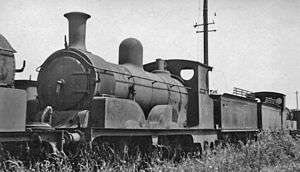LSWR A12 class
The A12 locomotives of the London and South Western Railway were built between the years 1887 and 1895 to the design of William Adams. Ninety of the locomotives were built, fifty at Nine Elms Works and forty by Neilson and Company, although the latter together with the final twenty from Nine Elms were officially known as the O4 class. They were unusual for their time, with a wheel arrangement of 0-4-2. This arrangement was used by few of the other railway companies, and never proved popular (although the Great Northern Railway had 150 such locomotives). They bore the nickname "Jubilees", because the first batch appeared in the Golden Jubilee of Queen Victoria's reign.
| LSWR A12 class | |||||||||||||||||||||
|---|---|---|---|---|---|---|---|---|---|---|---|---|---|---|---|---|---|---|---|---|---|
 Withdrawn A12 class No. 555 dumped at the far end of Eastleigh Locomotive Yard 11 July 1946 | |||||||||||||||||||||
| |||||||||||||||||||||
| |||||||||||||||||||||
| |||||||||||||||||||||
| |||||||||||||||||||||
History
The 90 examples of the class were built in batches, as shown in the following table.
| Year | Order | Builder | Quantity | LSWR numbers | Notes |
|---|---|---|---|---|---|
| 1887 | A12 | LSWR Nine Elms | 10 | 527–536 | [1] |
| 1888 | E1 | LSWR Nine Elms | 10 | 537–546 | [1] |
| 1889 | M2 | LSWR Nine Elms | 10 | 547–556 | [1] |
| 1893–94 | O4 | LSWR Nine Elms | 10 | 597–606 | [1] |
| 1892–93 | — | Neilson & Co. 4506–4545 | 40 | 607–646 | [2] |
| 1894–95 | K6 | LSWR Nine Elms | 10 | 647–656 | [1] |
All 90 passed to the Southern Railway in 1923, following the introduction of the Grouping Act.
Withdrawal
Withdrawals started in 1928, with four of the class surviving to Nationalisation. The four operated by British Railways were all withdrawn in its first year (1948).
| Year | Quantity in service at start of year | Quantity withdrawn | Locomotive numbers | Notes |
|---|---|---|---|---|
| 1928 | 90 | 6 | E529, E535, E542, E548, E552, E553 | |
| 1929 | 84 | 13 | E528, E531–E533, E536, E537, E540, E543, E544, E547, E549, E550, E556 | |
| 1930 | 71 | 3 | E527, E539, E546 | |
| 1931 | 68 | 6 | E530, E534, E538, E541, E545, E554 | |
| 1932 | 62 | 6 | 551, 607, 608, 610, 653, 656 | |
| 1933 | 56 | 9 | 602, 604, 626, 631, 633, 639, 645, 647, 651 | |
| 1934 | 47 | 1 | 601 | |
| 1935 | 46 | 3 | 603, 621, 635 | |
| 1936 | 43 | 4 | 605, 616, 622, 655 | |
| 1937 | 39 | 4 | 611, 619, 632, 640 | |
| 1938 | 35 | 3 | 617, 628, 650 | |
| 1939 | 32 | 1 | 646 | 613, 620, 624, 625, 629, 642, 644 withdrawn and then reinstated |
| 1944 | 31 | 1 | 555 | |
| 1946 | 30 | 12 | 599, 600, 606, 612, 613, 615, 620, 623, 637, 641, 644, 649 | 612 transferred to Departmental stock as 3191S, later BR DS3191; scrapped 1951 |
| 1947 | 18 | 14 | 597, 598, 609, 614, 624, 625, 630, 634, 638, 642, 643, 648, 652, 654 | |
| 1948 | 4 | 4 | 618, 627, 629, 636 |
Preservation
None of the locomotives were preserved, and all 90 were cut up for scrap.
Notes
- Bradley 1967, p. 41.
- Bradley 1967, p. 41–42.
References
- Bradley, D.L. (1967). Locomotives of the L.S.W.R.: Part 2. Kenilworth: RCTS.CS1 maint: ref=harv (link)
- Railway Magazine. March 1925. Missing or empty
|title=(help)